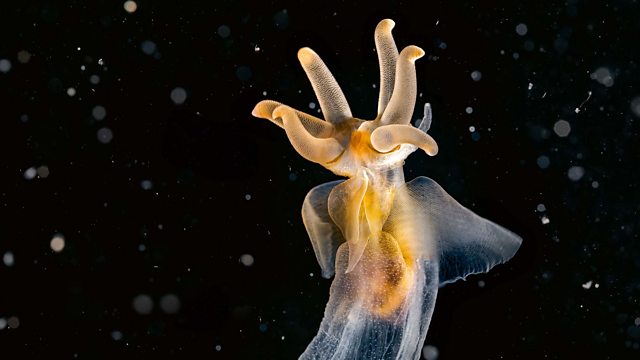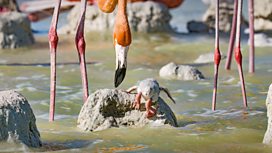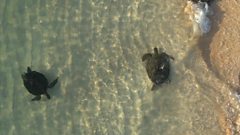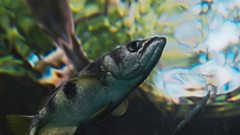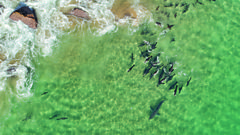Coasts
Sir David Attenborough explores the dangerous frontiers created by the world's coasts, where animals fight for survival amidst constant change.
Sir David Attenborough explores the dangerous frontiers created by the world's coasts, where animals fight for survival amidst constant change.
On South Africa’s Robberg Peninsula, thousands of Cape fur seals are squeezed onto a small ledge. A yearling pup escapes into the water, where the clumsy youngster becomes nimble and graceful. In recent years, this coast has been home to unprecedented numbers of great white sharks, and the seal colony must band together if they’re to see off the world’s most notorious predator.
The Arctic coast is the scene of the biggest seasonal transformation on earth, and the melting of billions of tonnes of ice brings short-lived opportunities to these coastal waters. Animals arrive en masse, perhaps the strangest of which is the sea angel. This beguiling creature has a devilish side – it’s a voracious predator whose ambush wouldn’t be amiss in a sci-fi horror.
On Namibia’s infamous Skeleton Coast, where the world’s oldest desert meets the cold Atlantic, we meet some unexpected residents. Hungry lions discover this coast for the first time in 40 years and try their luck in a huge seabird colony.
Coasts attract visitors from far afield. A southern right whale reaches her journey’s end at Peninsula Valdes, Argentina. In British Columbia, terrestrial garter snakes take the plunge into chilly waters in search of a meal.
In tropical Raja Ampat, Indonesia, coral reef is sheltered by forest. Mangrove trees are salt-tolerant and rooted in the seabed, providing a unique opportunity for archer fish, which use jets of water like arrows to shoot down insects from high above.
By contrast, the shallow lagoons of Mexico’s Yucatan are very exposed. It’s here in these hostile, hypersaline pools that Caribbean flamingos choose to nest, but can their offspring survive the tropical storms that have arrived early?
Coasts are the front line in our changing world. Increasingly unpredictable storms and sea level rises are urgent threats to those that make their homes near the coast, including nearly 40% of the world’s human population.
On tiny Raine Island, tens of thousands of female green turtles come ashore to nest, but many are stranded by the ebbing tide. The island is on borrowed time. This, the world’s largest green turtle rookery, is set to disappear beneath the waves. The end of the episode reveals the speed of change over the course of Sir David's lifetime. His was the first filming expedition in 1957. Little could he have known just how much the island would change in 66 years.
Last on
More episodes
Previous
You are at the first episode
Next
![]()
In pictures: Coasts
Take a look at some highlights from the first episode of Planet Earth III
![]()
Test your knowledge on Coasts with C±«Óãtv
Visit the C±«Óãtv website to have a go at the quiz
Clips
-
![]()
The devilish side of the sea angel
Duration: 01:01
-
![]()
Nature's marksman: the archer fish
Duration: 01:18
-
![]()
Great white shark vs fur seals
Duration: 03:00
Credits
| Role | Contributor |
|---|---|
| Presenter | David Attenborough |
| Production Manager | Bronwen Thomas |
| Executive Producer | Michael Gunton |
| Series Producer | Matt Brandon |
| Series Producer | Jonny Keeling |
| Producer | Nick Easton |
Broadcasts
- Sun 22 Oct 2023 18:15
- Sat 28 Oct 2023 15:30±«Óãtv One Wales & Wales HD only
- Sun 29 Oct 2023 15:40±«Óãtv One except Wales & Wales HD
- Tue 12 Dec 2023 07:50
Featured in...
![]()
Earth Day
Facts about the environment and the challenges facing our planet to mark Earth Day.
![]()
Escape to Nature
Cast off the stress and relax with stunning images from the natural world.
![]()
Our Planet Now
Facts about the environment and the challenges facing our planet.
![]()
Family Favourites
Must watch shows from across the ±«Óãtv
![]()
Sir David Attenborough
Sir David Attenborough's amazing programmes from the 1950s to the present day.
![]()
Most Watched of 2023
The most popular documentaries of 2023 on iPlayer all in one place
![]()
Sir David Attenborough
His incredible programmes and his amazing career - all in one place
![]()
Wonderful Wildlife
Explore the world around you with natrual history from across the ±«Óãtv ...
![]()
Family Favourites
All your favourites from across the ±«Óãtv
![]()
Science & Nature
Discovering the ±«Óãtv 's Signed Science & Natures programmes
![]()
iPlayer 13-15 ±«Óãtvpage :: Documentaries
iPlayer 13-15 ±«Óãtvpage - Documentaries
![]()
iPlayer Science and Nature Category :: Featured Episodes
iPlayer Science and Nature category featured programmes
Explore AR animals and their habitats in ‘Habitat Explorer’ or order a poster ‘Our Changing World’ to make origami animals!
Visit The Open University website to learn about fascinating animals in their habitats
